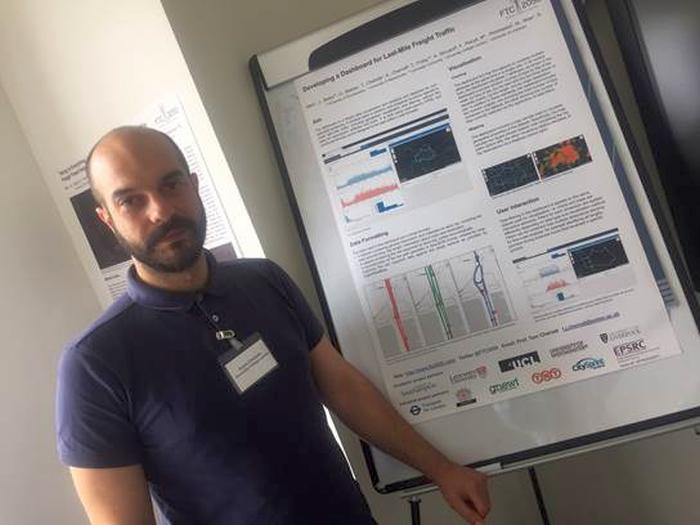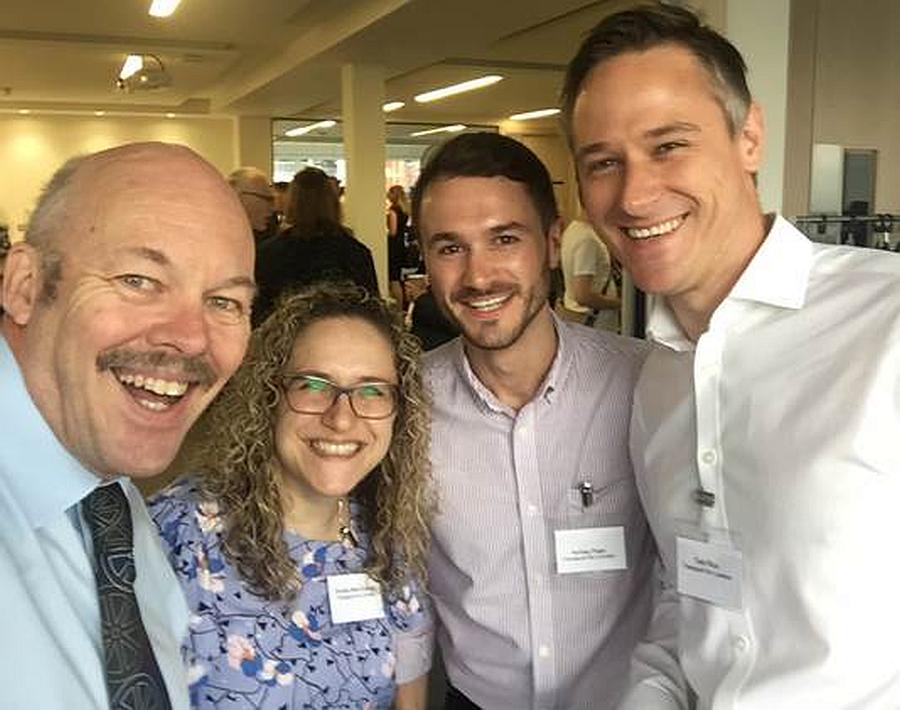An exclusive review from TfL to Corporation of London on congestion, kerbside, compliance and clean air for logistics.
Fast Green & Free deliveries, overcoming the Last Mile Challenge.
FTC Freight Traffic Control conference in the City of London.
LSA were in the City of London this week, Tuesday in a full house multi-modal audience focused on final mile.
The full house was a culmination of a three-year programme: FTC2050 project linked themes, customer behaviour, future from operator’s perspective and new systems for problems in last mile, with infrastructure and policy needs.
Folk stacked and racked in the cool, air-conditioned University lecture room of London City campus in Finsbury Sq in the heart of ULEZ clean air zone. A healthy turnout, mixed, academics with operators, consultants and local authorities for lectures and poster events to showcase, TfL strong in team including Tom Rice delivering a keynote.
The big statements
Dr Maja Piecyk, University of Westminster, ‘Freight depots moving ever further out from central London because of availability and affordability of land.’
Tom Cherrett, Professor of Logistics, University of Southampton, ‘multi-tenant buildings are a challenge for signatures as is unsecured delivery to absent homes and flats.’
Professor Phil Greening, Heriot-Watt University, Looking at electrification to de-carbonise road freight, it's going to be incredibly difficult to do this by 2050.
You may need to re-negotiate service delivery with your customers when using electric vehicles. EV charging times impacts on delivery time.
Distribution centres of the future will become power hubs.
Last-Mile Logistics in London at the FTC conference
Infrastructure and Policy Needs for the Last Mile
A Policymaker’s Perspective, Tom Rice, Transport for London
Tom delivered the policy keynote at the FTC 2050 City of London final mile freight conference. ‘80% sustainable mode-share by 2041’
Tom explained the TfL role, an employer of twenty five thousand people, the fifth largest land-owner in London, we are a curator and promoter of best practice, we are an employer, land owner and motivator. Tom spoke ULEZ, Direct Vision standard, the Freight and servicing action plan, zero emission zone guidance and the London lorry control scheme.
Personal deliveries at TfL, we have encouraged our staff not to receive home deliveries in the office. We need to get under the bonnet of this one, clearly every delivery that was coming to our building is going somewhere else, is there someone in when it gets there?, acting for best practice we want to understand this. We have click-and-collect lockers in our estate, we are aware these are popular and we are looking to expand this.
TfL policy, acting as a curator & promoter for freight, demonstrating projects including the portering and walking deliveries. Consolidation of waste collection including Bond Street and food deliveries at Somerset House. Healthy Street Fund for business includes match funding for projects including waste compactors and building networks for groups to share experience of other groups. Responsible consumer choices, clearly e-commerce is growing, we want to promote best practice choice for goods and time scale of delivery. We are engaging marketing innovators, looking at road work impacts is a recent example.
Summary of the Logistics academics' keynotes at FTC 2025
Simon Connick, DfT head of Office for Science, Department for Transport opened,
‘Freight is a multi-modal challenge for DfT. We work with our agencies and partners to support the transport networks. We are facing unprecedented changes, more changes than in the last hundred years with the new business models of e-retail. How can we avoid the challenges of the change ahead of us? We are looking for positive outcomes. Freight, drones, platooning, home delivery robots, Mole solutions using underground solutions linking freight from outside the city. Simon talked 'Teresa May announcement committing to net zero emissions by 2050.’
‘Van delivery last mile, vans are fastest growth in transport, accounting for 78% of traffic in 2018. Freight contributes to congestion and emissions. We need to address a clean, low-cost freight revolution, we need to manage freight and congestion and to recognise freight's significance.‘
‘We have a science advisory council in DfT; a recent event looked at ‘encouraging more sustainable on-line shopping, exploring the use of digital twins and understanding logistics implications. Across Government we are doing a lot of work and research, we need to bring these together and go forward. Talking Last Mile call for evidence, we have been collecting further evidence, overview, lack of cycling infrastructure, lack of charging infrastructure, additional cost of low weight/volume, opportunities to improve air quality, reducing congestion and job opportunities. We have a response to the call on-line, it focuses on e-cargo, 2 million pounds for e-cargo bikes. ‘
Tom Cherrett, Professor of Logistics, University of Southampton took the second keynote slot,
‘The false assumption of free delivery. Meeting the needs of retailers, the average letterbox will not take half of the deliveries, multi-tenant buildings are a challenge for signatures, unsecured delivery to absent homes and flats.’
The Freight Traffic Control project has worked closely with TNT and Gnewt Cargo in alliance with the lead Universities of Westminster, Liverpool and Southampton to look at Parcel Delivery in Central London: Current Operating Patterns and Future Challenges. Growth of B2C, B2B and E-Commerce.
‘Early in the project pre-GDPR, we were tracking vehicles and rounds for delivery, blending routes, taken to look at the driver's daily role, working with 18 parcel carriers in one day in London, van stopping about 38 times, driving seven km, driver walking ten kms, the van is stationary for 68% of the time, the van asset sat at the roadside.’
Driver challenge is often to work their own schedule, using their knowledge of parking, traffic warden locations, nine-digit codes to enter multi-occupancy buildings. In the UK we often deliver to desk, 28% of deliveries were to people inside buildings, as much as thirty per cent of time spent in the buildings to complete the delivery. A driver who knows the patch well is very ordered, novice drivers, courier driver standing in for holiday, a typical 8km route took 19km, not familiar with parking spaces, such as the Barbican, extra time for the driver to sign in when they are not known to security.
Looking at density of delivery in urban areas, the data has been rich and mapped intensity in the Urban areas, we can map speed average to the impact of delivery for parcel carriers.
Dr Maja Piecyk, University of Westminster working with Julian Allen.
Freight depots moving ever-further out from central London because of availability and affordability of land. Talking Fast Green and Free, future of Home Delivery, ‘UK parcel market (Mintel 2017) 2.8 billion items delivered. 30% decrease in road capacity 1993 to 2009.’ ‘Using an inexperienced driver brings a particular challenge to operating cost. In the medium term operating cost will rise for last mile, driving time is likely to increase as much as 60%. The first intermediate conclusion is we need to act, FTC sessions identified, portering delivery systems, optimising routing, bringing depots closer to concentrated delivery. Looking at clustering and routing, driving and walking, both driving and working element impact on operating cost, reducing driving time is an action of routing.
‘Key conclusions include, the need for policy intervention to drive implementation of solutions, need for a shift in culture to improve sustainability of last mile, need for more data on urban freight delivery.’
Professor Phil Greening, Heriot-Watt University,
Looking at electrification to de-carbonise road freight, its going to be incredibly difficult to do this by 2050.
You may need to re-negotiate service delivery with your customers when using electric vehicles. EV charging times impacts on delivery time.
Distribution centres of the future will become power hubs.
Prof Greening took a new lens focused on food delivery. ‘We can no longer look at historical data, home delivery is fast-moving, technology, operations and policy will define future logistics. The way we do logistics is dependent on the technology available, demand for logistics depends on customer behaviour. What will logistics evolve into? We need a robust solution from parameters and variables that show a system most likely to occur, key to this is consumer behaviour and behaviour of companies in the supply chain.
Finding a solution and a route to electrification with vans. A four-stage heuristics model. First step to analyse empirical data from the retailer, the second step to develop an agent-based simulation to imitate the retailer’s fleet. The third step, introduce electric vans in the simulation, compare diesel fleet, then add battery range and charge power constraints. The fourth step, Identify potential locations. We have mapped Manchester and should be able to use the same methodology for London, Cambridge and other locations. When we run the model do we get benefit from the diesel data to the electric fleet? The first answer is electric vehicles can deliver the same number of deliveries as diesel vehicles. However because of charging time, untimely delivery percentage will rise. You may need to re-negotiate service delivery with your customers when using electric vehicles. EV charging times impacts on delivery time. Distribution centres of the future will become power hubs. Charging time will impact on the way you schedule delivery. There is a great need for data to make the decisions for the future, give us your data for our model to run.
Freight Traffic Control 2050
The academic students shared their latest research.
Poster presentations in a more detailed and informal way took the next stage.
Optimised Routing Strategies for the Last Mile, Tolga Bektas, University of Liverpool, looking at routing a driver, as many as ten thousand possibilities, when we looked at the driver behaviour we focused on clusters, added parking and time-sensitive, delivery of urgency first. In the second stage of the project we looked at a number of carriers coming together, confidentiality and technology was a challenge as was competition, we looked at sharing micro-depot space and sharing porters.
Changes to Logistics Operations Resulting from Electrification of Home Delivery Vehicles, Nadia Taou, Heriot-Watt University. Looking at transition to electrical vehicles, focus on charging, return to base for charge or end of day charging, the business model must be real, the drivers are the key cost.
Developing a Dashboard for Last-Mile Freight Traffic, Dr Kostas Cheliotis, UCL, University College London. Project included lots of operators and a big dataset, communicating the different data with many aspects to look at how to visualise a tool for interested parties and broader audiences that is easy to use as a last mile dashboard. You can use the freight dashboard from phones to tablets on a single page.

Developing a dashboard for last mile freight, Dr Kostas Cheliotis UCL
Incorporating Consumer Behaviour into the Optimisation of Van Deliveries in Cambridge, Pratyush Dadhich, Heriot-Watt University. A consumer model, set in Cambridge, who many supermarkets? A customer choice made online, the retailer then places the order and then delivery comes from store or warehouse, in our research mainly from the store. Customer segmentation showed many clusters in Cambridge. Segmentation study looked at future trends.
Co-designing Digital Services for Collaborative and Sustainable Logistics. Oliver Bates, Lancaster University. This project was a co-design with operators, a data background with data management and service design. An idea for a toolkit with field work to create real impact.





